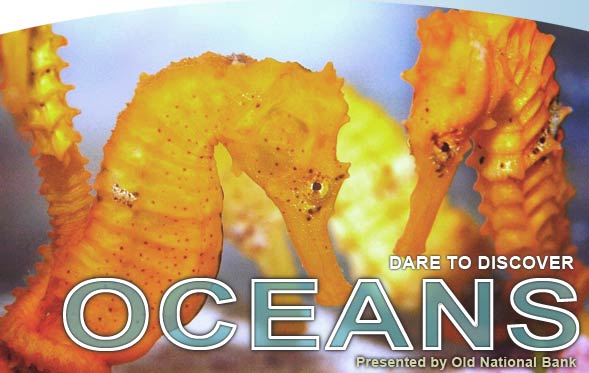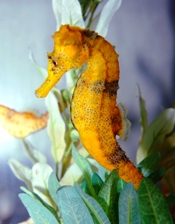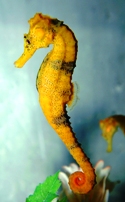 |
| OCEANS SEAHORSE EXHIBIT |

|
| AT THE INDIANAPOLIS ZOO!!!! |
Seahorses
In the Indianapolis Power & LIght Company presents Seahorses Exhibit, Visitors learn about
how Seahorses Swim, how they Eat, and why they have the Tail of a Monkey, a Head like a Horse, and a Mouth like an Aardvark.
And, Visitors will find out exactly why it's the Father Seahorses-not the Moms-that give Birth to the Babies.
The Seahorses on Display include the Long Snout Seahorse, Lined Seahorse and Potbelly Seahorse.
Exhibit highlights include Three Towering Cylindrical Tanks so that Visitors can get a 360 Degree view of the Seahorses.
| SEAHORSE-RILEY |

|
| AT THE INDIANAPOLIS ZOO!!! |
BACKGROUNDER-SEAHORSES
"Seahorse" is a general name for a group of about 34 Species of these beautiful, little Fish,
ranging in Size from 1/8 of an Inch to Seven Inches in Length. They are found in Temperate and Tropical Oceans Worldwide,
but only near the Coasts. If anyone has been to the Beach anywhere from Maine to Florida, they have been near Seahorses, but
probably never saw them, since they hide so well.
All Seahorses belong to the Genus Hippocampus, from the Greek Words for Horse (Hippos) and
Sea Monster (Campus). They are all Members of the Family Syngnathidae, from the Greek syn, meaning together or fused, and
Gnathus, meaning Jaws. Other Fish in the Family Syngnathidae include Pipefishes, Pipehorses, and Sea Dragons.
Stars throughout History, Seahorses are represented in Artwork from Ancient Rome and Greece,
often in the guise of their Namesakes the Equine Horse. But Seahorses bear little real resemblance to Equines. Seahorses are
True Fish. they have Gills to breathe Underwater, Fins to propel themselves, and Skin adapted to an Aquatic Environment.
Their Heads are at Right Angles to the Body and their Fully Prehensile Tails wrap around Sea
Grass Stems, Corals, Sticks, or any other suitable Natural or Artificial Object.
| SEAHORSE-RILEY |

|
| AT THE INDIANAPOLIS ZOO!!!! |
Instead of the Scales found on most Fish, Seahorses have a
Thin Layer of Skin stretched over a series of Bony Plates visible as Rings around the Trunk. These Rings are useful in identifying
Species, as are the Cheek Spines and Coronet (a Crown-like group of Spines on the Top of the Head). While these Plates are
not a True Exoskeleton like Crabs have, they do make the Seahorse's Body very strong and resistant to being eaten by anthing
that cannot swallow them whole. These Traits, along with a Pouch for the Young and Eyes that swivel independantly of each
other, lend to the Unique Nature of these Fish.
Seahorses are Masters of Camouflage, changing Color and growing Skin Filaments to blend in
with their surroundings. Short-term Color changes may also occur during Courtship Displays and Daily Greetings.
Male and Female Seahorses can be told apart by the presence of a Brood Pouch on the Male.
Seahorses have no Stomach or Teeth. They suck in Prey through a Tubular Snout and pass it
through an inefficient Digestive System. Like other Fish, they breathe through Gills, extracting Oxygen from the Water that
passes over them. Unlike other Fsih, however, the Gills are small and compacted, almost "grape-like" in structure. Seahorses
swim using propulsive force of a quickly oscillating Dorsal Fin, and use the Pectoral Fins on either side of the Body for
Steering and Stability.
They are more adapted to maneuverability than speed, and therefore rely primarily on Camouflage
to avoid detection from Predators.
Seahorses lay Eggs rather than giving Birth. Although, strangely enough, the Female will transfer
the Eggs to a special Brood Pouch on the Male and the Male will carry the Eggs until they hatch.
The Male then "gives Birth" to the Young. This Reproductive Method confused Scientists for
Years. This unusual Mode of Reproduction is the most extreme form of Male Parental Care yet discovered, although it arises
from a general bias towards Parental Care among Fishes.
Sexual Maturity in Males is usually determined by the presence of the Brood Pouch. Male Seahorses
are able to become Pregnant any time during the Breeding Season, which varies with Species, and is most likely dependant
on Temperature of the Water.
Most Species of Seahorses are Monogamous, forming Pair Bonds that last the entire Breeding
Season (and perhaps even last over several Breeding Seasons), although some Species may not be Pair-Bonded. Pair Bonds are
reinforced by Daily Greetings in which the Female and Male change Color and promenade and pirouette together. This Dance lasts
several minutes, and then they separate for the rest of the day.
The Greetings occur throughout the Male Pregnancy, and are even thought to ensure that the
Male and Female are ready to re-mate at the same time. Once the Male has given Birth and it is time to re-mate, sometimes
only hours later, this Greeting is extended into a Courtship that for one Species lasts up to Nine Hours. The Female deposits
her Eggs into the Male's Brood Pouch, where he fertilizes them and they become embedded in the Pouch Wall. The Pouch acts
like the Womb of a Female Mammal, providing Nurtrients and Oxygen to the Developing Embryos while removing Waste Products.
Pregnancy lasts between two and four weeks, and at the end of Gestation, the Male goes into
Labor (usually at Night), pumping and thrusting for Hours to release his Brood. Young are Miniature Adult Seahorses, independant
from Birth, and receive no further Parental Care.
Newborns of most Species Measure 7-12mm. The Number of Young released averages about 100-200
for most Species, but can be as low as five for the smaller Species, or as high as 1,500.
Seahorses are also not strong Swimmers, unlike the Horse, which is known for its running ability.
|

